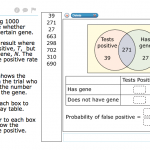Why Some State Test Results Are Less Honest Than Others

booleansplit / Flickr
The difference in passing rates between state and federal tests has been dubbed the proficiency, or honesty, gap.
Some states are telling students and parents they are better at reading, writing, math and other subjects than they really are, according to a new website from the Foundation for Excellence in Education.
The website, WhyProficiencyMatters.com, tracks the percentage of students scoring at grade level on state tests — “proficient” in education jargon. The site then compares those rates to how well students perform on the National Assessment of Education Progress, or NAEP. Students take the NAEP every two years and the exam results are considered the gold-standard of education data.
The group has found that many states report a much higher percentage of students are proficient on state tests than are proficient on NAEP. Foundation for Excellence in Education director Patricia Levesque says some states are telling students they’re ready for college or the workforce when they might not be.
“It’s really important to look at what is the gap between how your students are doing on the national test compared to how they’re doing on the state test,” she said, “because that gap tells you, basically, how honest is your state being to parents with how their individual child is doing.
“We’ve been telling parents ‘Oh no, your child is fine.’ But then when they get to college they’re actually not ready.”
For instance, 39 percent of Florida fourth graders could read proficiently according to the 2013 NAEP results. But 60 percent of fourth graders were proficient in reading, according to state test results.
The gap in Florida is smaller than in most states — Florida ranks 12th best. But Levesque said that still means 21 percent of students and their parents were told the student was doing fine but might actually need more help.
By comparison, the gap between state results and national results in neighboring Alabama was about 50 percentage points — one of the largest differences in the country.
A recent study from the National Center for Education Statistics found that what some states considered proficiency for seventh graders was the equivalent to what other states considered proficiency for fourth graders.
Some argue that the gap isn’t the problem that the Foundation for Excellence in Education makes it. Curmuducation sums up those arguments here, but the biggest is that plenty of students who fail to earn proficiency on the NAEP still go on to finish college.
Most states — including Florida — are now using math and reading standards based on Common Core. Two national tests were created using federal grants to measure the standards. States using those tests are supposed to agree on a common measure of proficiency.
But Florida and 21 other states chose not to use those exams. Florida created their own exam. Levesque said it’s not clear whether the switch to Common Core will mean more or less honesty in state test results.
Florida parents will have a chance to weigh in later this year when the State Board of Education, parents, teachers, business leaders and others choose which scores will mean students are at grade level in a subject.
